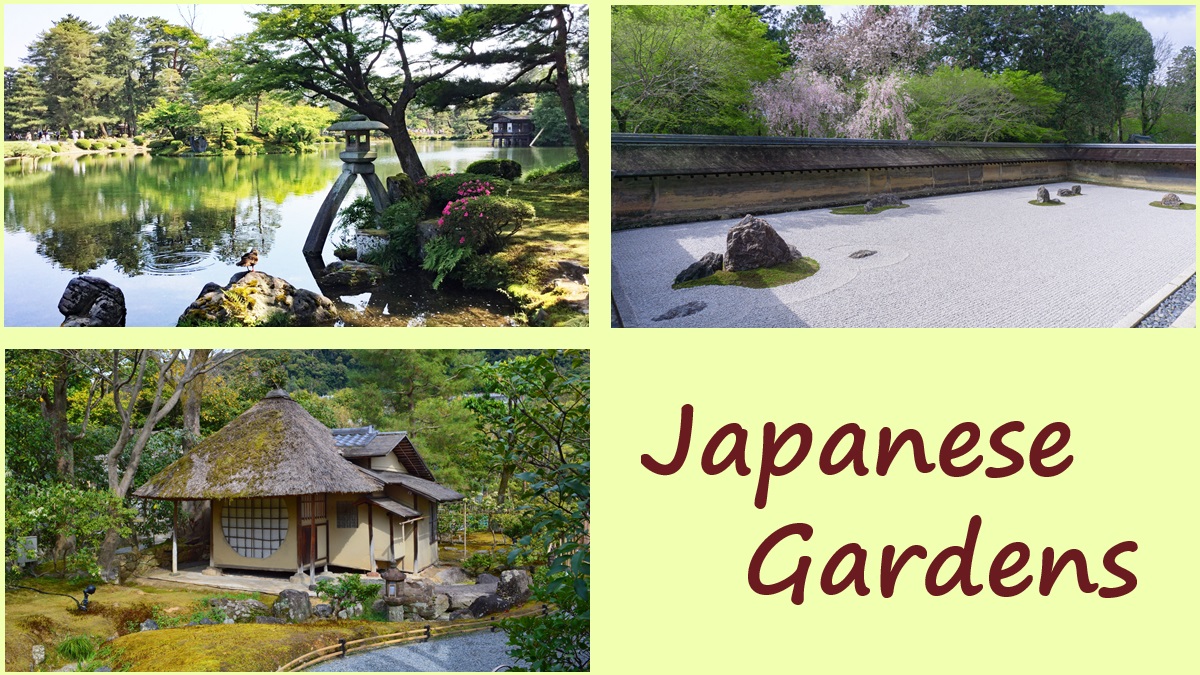Japanese gardens in Japan
Japanese gardens had been constructed in castle, residence of high‐ranking person, major Buddhist temple, etc.
Japanese garden is a small world expressing beautiful nature.
Unlike western style garden, artificial and geometrical views are not seen.
Japanese garden may pursue the beauties of nature.
In many gardens, a few ponds are placed in the center of the site, and stones, rocks, trees, streams, etc. are set around the pond.
In wide garden, walkways and arbors are set up.
The type of the garden is called "Chisen-teien" (池泉庭園) in Japanese, and it is simply translated as "Water garden" in English.
Some famous gardens are constructed by using the real background landscape such as far mountains, forests, castle, etc.
It is one of landscape gardening techniques in Japan, and it is called "Shakkei" (借景) in Japanese.
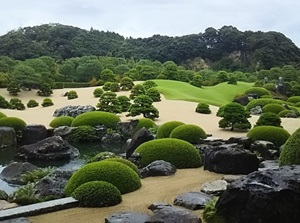
Japanese garden in Adachi Museum of Art
(Shimane Pref.)
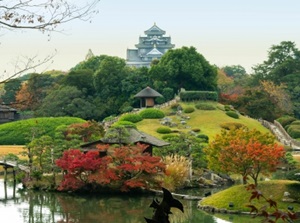
Korakuen with 'Shakkei' of Okayama Castle
(Okayama Pref.)
Another type is the garden without water, and it is called "Karesansui" (枯山水, Dry landscape).
The main part of garden is covered with white sand or gravel, and it expresses water such as sea, pond, river, etc.
And stones, rocks, trees, mosses, etc. are set up on or around it.
It is mainly seen in Zen Sect temples, so the view is abstract and meaningful.
You gaze quietly at the garden from a room, and you ask yourself what it means.
One more type of Japanese garden is "Roji" (露地, Teahouse garden).
Small garden is set up around the teahouse for the tea ceremony or on the places between the buildings in the residence.
When the visitors walk through there, they can enjoy the austere scenery.
Stepping stones to walk and water bowl to wash hands are set up in the garden.
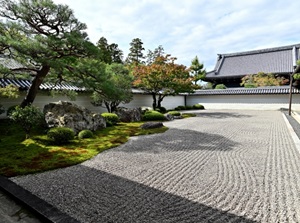
'Karesansui' garden in Nanzenji temple
(Kyoto Pref.)
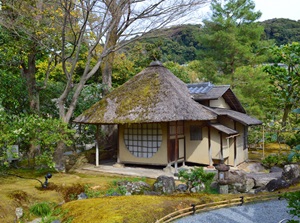
Teahouse and 'Roji' garden in Kodaiji
(Kyoto Pref.)
Three Great Gardens Popular gardens Gardens in Tokyo Gardens in Kyoto
Three Great Gardens of Japan
Three Great Gardens of Japan is the most famous Japanese gardens.
It is said that these gardens had become popular since the end of the 19th century.
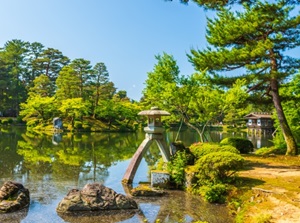
Kenrokuen (Ishikawa Pref.)
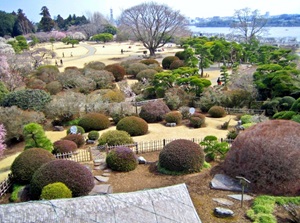
Kairakuen (Kyoto Pref.)
Kenrokuen (兼六園, Ishikawa Pref.) is in Kanazawa city.
It was built as the garden of Kanazawa Castle in 1676.
Visitors can enjoy the scenery in all seasons, and snow in winter is also beautiful.
Korakuen (後楽園, Okayama Pref.) is in Okayama city.
It was built near Okayama Castle in 1700.
The castle and surrounding mountains are also included in the scenery of the garden.
Kairakuen (偕楽園, Ibaraki Pref.) is in Mito city.
It was built as a park for the people by the lord of Mito domain in 1842.
It is famous for the ume (Japanese plum) blossoms in early spring.
Popular gardens all over Japan
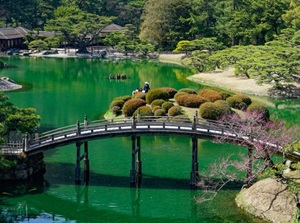
Ritsurin Park (Kagawa Pref.)
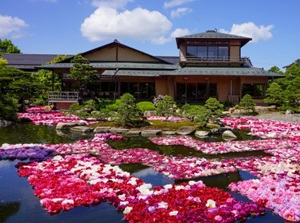
Yuushien (Shimane Pref.)
Adachi Museum of Art (足立美術館, Shimane Pref.) is an art museum in Yasugi city, and it exhibits Japanese-style paintings in recent and modern times.
Various types of Japanese garden are arranged around the museum, and they are ranked at the top in an American magazine "The Journal of Japanese Gardening" every year.
Ritsurin Garden (栗林公園, Kagawa Pref.) is in Takamatsu city, and it was originally a garden of a samurai house built in the 1680s.
There are many hills and ponds, and it is the largest garden in Japan.
Yokokan Garden (養浩館庭園, Fukui Pref.) is a garden built in villa of samurai lord of Fukui Castle in the 17th century.
Wide pond spreads in the site and the Japanese houses by the pond are also beautiful.
Yuushien (由志園, Shimane Pref.) is a garden park in a small island in Lake Nakaumi near Matsue city.
There is a pond and streams with waterfall flow into there.
Especially, peony in spring is beautiful.
Sankeien (三渓園, Kanagawa Pref.) is a garden opened in 1906, and it is in Yokohama city.
It is like an outdoor museum with moved and reconstructed old Japanese buildings of national important cultural property.
They are dotted in the wide site of Japanese garden.
Popular gardens in Tokyo
Edo became a capital as political center in 1603.
The provincial lords all over the country set the second residence as a branch office in Edo period.
Powerful lord made a garden in the residence.
After feudal samurai period, Edo was renamed Tokyo in 1868.
Modern industry developed and Tokyo became the center of the Japanese economy.
Some large enterprises made a garden in the founder's residence as a symbol of wealth.
Such Japanese gardens are dotted in Tokyo.
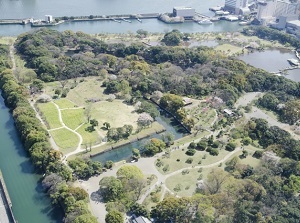
Hamarikyu Gardens
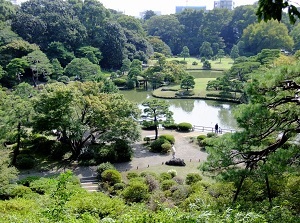
Rikugien
Hamarikyu Gardens (浜離宮恩賜庭園) faces Tokyo Bay and was built as the garden in the villa of Shogun family in 1654.
It became a villa of the Emperor's family in 1868, and was granted to Tokyo Prefecture in 1945.
Kyu-Shibarikyu Gardens (旧芝離宮恩賜庭園) near Hamarikyu Gardens was built as the garden of samurai residence in 1686.
It also became a villa of the Emperor's family in 1875, and was granted to Tokyo Prefecture in 1924.
Koishikawa Korakuen (小石川後楽園) was built as the garden of samurai residence in 1629.
It involves elements of Chinese Confucianism.
Shinjuku Gyoen (新宿御苑) is a garden constructed in 1872 and was managed by Imperial Household Agency.
Japanese garden is in the part of the site and the whole area is a natural park.
Rikugien (六義園) was completed by an aide of Shogun in 1702.
It is said that the garden expresses the world of the Japanese poems created in the 10th century.
Kyu-Furukawa Gardens (旧古河庭園) was built by a financial combine in 1917.
It is a garden of Western-style residence and both Japanese style and Western style are mixed.
Former Yasuda Garden (旧安田庭園) was constructerd in the early 19th century.
The water in the pond is supplied from Sumida River.
Popular gardens in Kyoto
Kyoto was the capital of Japan from 794 to 1868, and many Buddhist temples were built from ancient times to the medieval period.
Most major temples have Japanese garden.
In some temples, we can enjoy views of the gardens of Karesansui type.
Very popular gardens are in the following temples and shrines.
Gardens of Buddhist temple in central Kyoto
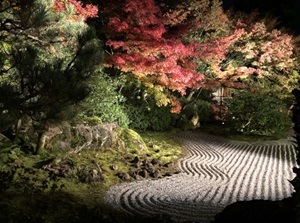
Garden in Entoku-in in autumn

Garden in Nanzenji
Shosei-en (渉成園) is the garden of Higashi-Honganji temple near Kyoto station, and it was built in 1653.
The garden is 200 meters square, and there are various spots around a pond.
Entoku-in (圓徳院) is a small temple, and is located near large Kodaiji (高台寺) temple.
There are some Japanese gardens in Kodaiji, and the garden in Entoku-in is beautiful and is designated as a scenic beauty in Japan.
Kenninji (建仁寺) is a Zen Buddhist temple founded in 1202, and it is located in Gion area.
There are some excellent Buddhist paintings, but a few gardens are also beutiful.
Shoren-in (青蓮院) is a Buddhist temple near Gion area.
It founded in 1150, and it had been related to imperial family.
Some Japanese gardens are set up around the buildings.
Nanzenji (南禅寺) is a big Buddhist temple built in 1291.
The main temple is a National Treasure, and many buildings are in the wide site.
Various Japanese gardens are set up around the buildings.
Daitokuji (大徳寺) is a Buddhist temple built in 1325, and is located in the northern part of central Kyoto city.
There are 24 small temples in the site.
Visitors can enter the four temples of them, and each temple have the garden.
Ryoanji (龍安寺) is a Buddhist temple founded in 1450 and it is located near Kinkakuji.
The temple is near a pond, but the "Karesansui" garden in the temple is well known.
Tofukuji (東福寺) is a Buddhist temple built in 1236, and it is located to the southeast of Kyoto station.
There are many buildings and several beautiful garedens are around them.
Some of them have unique geometric design.
Gardens of Buddhist temple in the suburbs of Kyoto
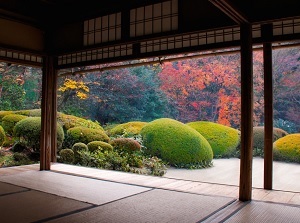
Garden in Shisendo
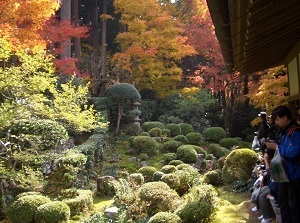
Garden in Sanzen-in
Shisendo (詩仙堂) was originally a villa of a samurai built in 1641, but it became a Buddhist temple in 1966.
The samurai was a good designer of Japanese garden and designed to enjoy the changing seasons in this garden.
Tenryuji (天龍寺) is a Zen Buddhist temple in Arashiyama area.
It is one of 17 constructions of Kyoto designated as World Heritage Site.
The garden with a wide pond is beautiful.
Saihoji (西芳寺) is a Buddhist temple founded in the 8th century.
It is famous for the garden covered with beautiful moss, so the temple is called "Koke-dera (Moss Temple, 苔寺).
To visit the temple, a reservation must be made in advance.
Sanzen-in (三千院) is an old Buddhist temple in Ohara district to the north of Kyoto.
It was founded in 788, and the buildings are in the forest.
There is a beautiful garden with the field of moss.
Byodo-in (平等院) is a Buddhist temple in Uji city to the south of Kyoto.
It is also one of 17 constructions of Kyoto designated as World Heritage Site.
It was built in 1052, and the garden including main hall is very famous.
Gardens of Shinto shrine and Imperial Villa
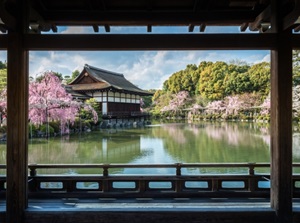
Garden in Heian jingu
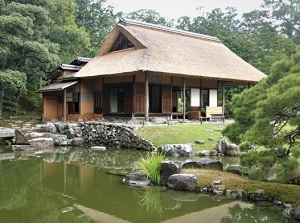
Garden in Katsura Imperial Villa
Heian jingu (平安神宮) is a Shinto shrine built in 1895.
It was burned down in an arson attack in 1976, and was rebuilt in 1979.
Wide garden surrounds the main shrine and there are three ponds.
Shugakuin Imperial Villa (修学院離宮) is also one of the villas of Emperor Family, and is in the northeastern part of central Kyoto.
It was built in the 1650s and has three Japanese gardens in the site.
We must apply for visit to Imperial Household Agency in advance.
Katsura Imperial Villa (桂離宮) is one of the villas of Emperor Family and is in the western suburb of central Kyoto.
The whole area is like a Japanese garden.
We must apply for visit to Imperial Household Agency in advance.

